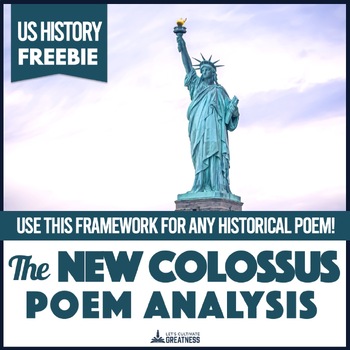

Source: Emma Lazarus, The Poems of Emma Lazarus, vol. Send these, the homeless, tempest-tost to me, I lift my lamp beside the golden door!" "Give me your tired, your poor, Your huddled masses yearning to breathe free, The wretched refuse of your teeming shore. "Keep, ancient lands, your storied pomp!" cries she With silent lips. From her beacon-hand Glows world-wide welcome her mild eyes command The air-bridged harbor that twin cities frame. At the time, Lazarus was involved in charitable work for refugees and was active in aiding Russian Jews who. Not like the brazen giant of Greek fame, With conquering limbs astride from land to land Here at our sea-washed, sunset gates shall stand A mighty woman with a torch, whose flame Is the imprisoned lightning, and her name Mother of Exiles. Why did Emma Lazarus refer to the Statue of Liberty as the new colossus The poem’s title, The New Colossus, was inspired by The Colossus of Rhodes the ancient statue of the Greek sun-god Helios on the island of Rhodes. 1973) John Bodnar, The Transplanted (1985) Philip Taylor, The Distant Magnet (1971) John Higham, Strangers in the Land (1955) Leonard Dinnerstein and David Reimers, Ethnic Americans: A History of Immigration and Assimilation (1975). "Other lands," wrote the Polish emigré Henry Sienkiewicz, "grant only asylum this land recognizes the immigrant as a son and grants him rights." When they were "sickened at last of poverty, bigotry and kings," wrote another immigrant, "there was always America!"įor further reading: Oscar Handlin, The Uprooted (1951 rev. A poem she wrote to help raise money for the pedestal, and which is carved on that pedestal, captured what the statue came to mean to the millions who migrated to the United States seeking freedom, and who have continued to come unto this day.Īs many modern scholars have noted, these words have an air of condescension, but the fact is that many native-born Americans and immigrants at the time did see themselves just as Lazarus portrayed them - wretched, nameless, "tempest-tost." For them Europe meant poverty and persecution, and America meant democracy and opportunity. Ironically, none of the speeches at the dedication of the monument in October 1886 even mentioned immigrants President Grover Cleveland spoke about Franco-American friendship and American ideals.īut the Jewish American poet Emma Lazarus saw the statue as a beacon to the world. France provided $400,000 for the 151-foot statue, and a fundraising drive in the United States netted $270,000 for the 89-foot pedestal. The statue, sculpted by Frédéric Auguste Bartholdi, had been conceived of as a gift of friendship from the people of France marking the two nations' commitment to liberty. Between 18, approximately 34 million persons immigrated to the United States, three-fourths of them staying permanently.įor many of these newcomers, their first glimpse of America was the Statue of Liberty in New York harbor. But by the middle of the nineteenth century, improvements in travel, combined with political upheaval and economic difficulties, led to a significant increase in the number of people crossing the Atlantic to seek opportunity in the United States. The wretched refuse of your teeming shore.America had always been a magnet to Europeans, at first primarily from the British Isles, and then from the continent. Your huddled masses yearning to breathe free, “Keep, ancient lands, your storied pomp!” cries she The air-bridged harbor that twin cities frame. Glows world-wide welcome her mild eyes command Is the imprisoned lightning, and her name Here at our sea-washed, sunset gates shall stand With conquering limbs astride from land to land

"Not like the brazen giant of Greek fame, With open minds, open arms, and open hearts, Our greatest sign of strength - our colossus - stems not from our conquests but rather from our compassion. At 138 years old, it seems there is still something we can learn from it. The similarities between 1883 and modern times are notable, which is one reason we feature this poem in this month’s Kinship guide. happened to experience a jump in immigrants from Europe, triggering 19th-century pundits to start inciting fear about the wave of newcomers. Then in 1886, when the statue opened to the public, the U.S. passed the Chinese Exclusion Act, which limited immigrants from a specific region for the first time in American history. Around the time Lazarus was writing the poem, the U.S. This was an important message given the context. Unlike the original Colossus - a famous Greek statue built to demonstrate power - Lazarus saw the Statue of Liberty as having a "maternal strength, one that would boldly and compassionately welcome newcomers." She wrote it to help raise money for the base of the Statue of Liberty in New York City (the statue itself a gift from France). They are from “The New Colossus”, a sonnet written by Emma Lazarus in 1883 (full text below). You have likely heard these words before. Your huddled masses yearning to breathe free.”


 0 kommentar(er)
0 kommentar(er)
